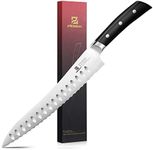Buying Guide for the Best Bread Knives
Choosing the right bread knife can make a big difference in your kitchen, especially if you often slice bread, cakes, or other baked goods. A good bread knife should cut cleanly through crusty loaves without crushing the soft interior, and it should feel comfortable and safe in your hand. When shopping for a bread knife, it's important to look beyond just the price and brand—focus on the features that will best suit your needs and the types of bread you most often enjoy.Blade LengthBlade length refers to how long the cutting part of the knife is, usually measured in inches or centimeters. This is important because a longer blade can handle larger loaves and make longer, smoother cuts, while a shorter blade is easier to control and store. Bread knives typically range from about 7 to 10 inches. If you mostly slice small rolls or sandwich bread, a shorter blade may be enough. For larger artisan loaves or if you want more versatility, a longer blade is a better choice.
Serration TypeSerration type describes the shape and size of the teeth along the blade's edge. This is crucial because the serrations help the knife grip and slice through tough crusts without squashing the bread. Some knives have large, widely spaced serrations, which are good for crusty, rustic breads, while others have smaller, finer teeth that work well for softer breads and cakes. Think about the types of bread you eat most often—choose larger serrations for hard crusts and finer ones for delicate or soft breads.
Blade MaterialBlade material is what the knife is made from, most commonly stainless steel or high-carbon steel. This matters because it affects sharpness, durability, and ease of maintenance. Stainless steel is resistant to rust and easy to care for, making it a good all-around choice. High-carbon steel can be sharper and hold its edge longer, but it may require more care to prevent rust. If you want a low-maintenance knife, go for stainless steel; if you prioritize sharpness and don't mind a bit of upkeep, high-carbon steel could be better.
Handle Comfort and MaterialHandle comfort and material refer to how the handle feels in your hand and what it's made from, such as wood, plastic, or composite materials. This is important for safety and ease of use, especially if you do a lot of slicing. A comfortable, non-slip handle reduces the risk of accidents and hand fatigue. Wooden handles can feel warm and traditional but may need more care, while plastic or composite handles are often more durable and easier to clean. Try to choose a handle that feels secure and comfortable for your grip.
Balance and WeightBalance and weight describe how the knife feels when you hold it and how heavy it is overall. This affects control and comfort during use. A well-balanced knife feels stable and easy to maneuver, while the right weight depends on your personal preference—some people like a heavier knife for more power, while others prefer a lighter one for better control. If possible, try holding different knives to see what feels best in your hand, especially if you plan to use it frequently.














